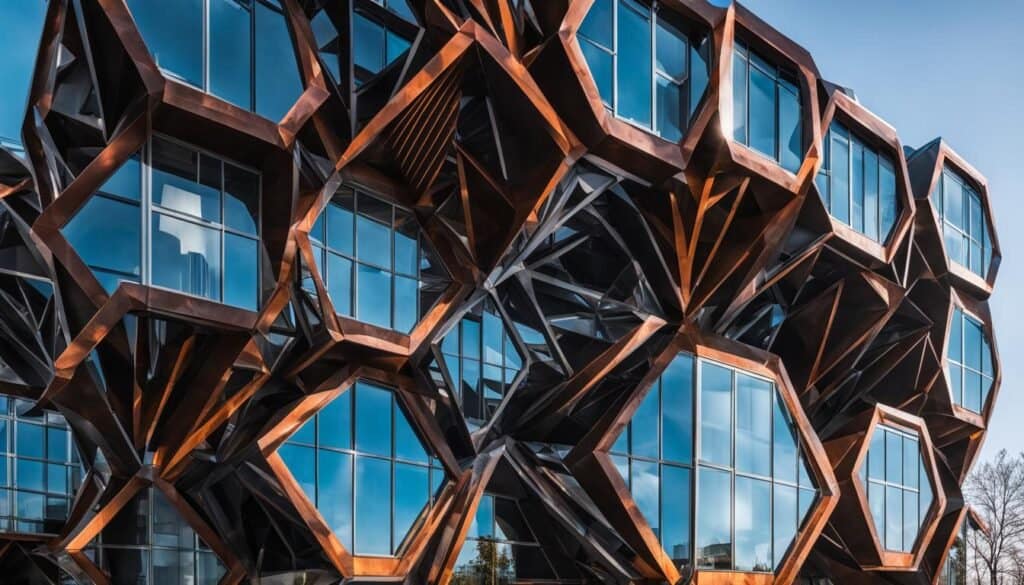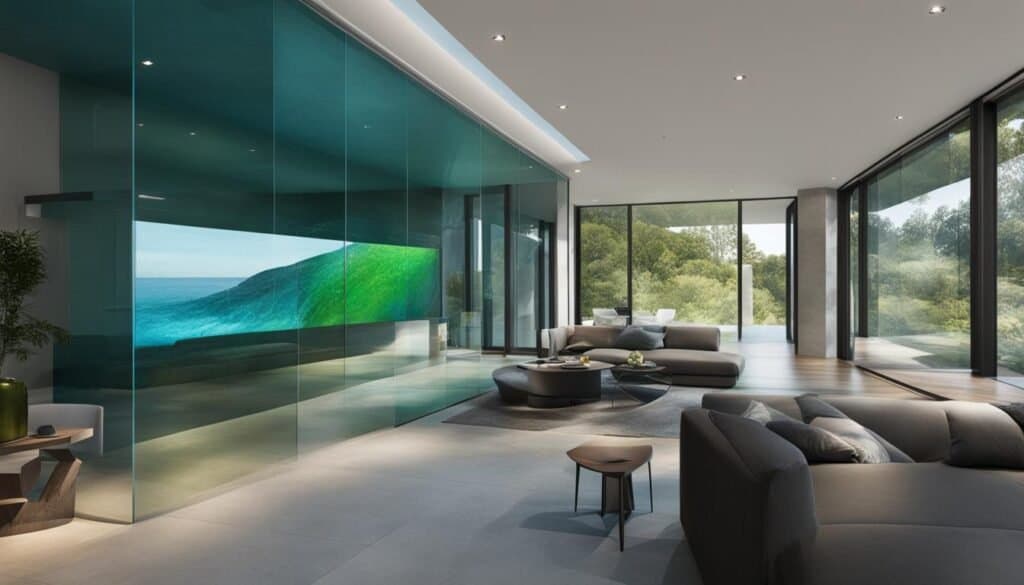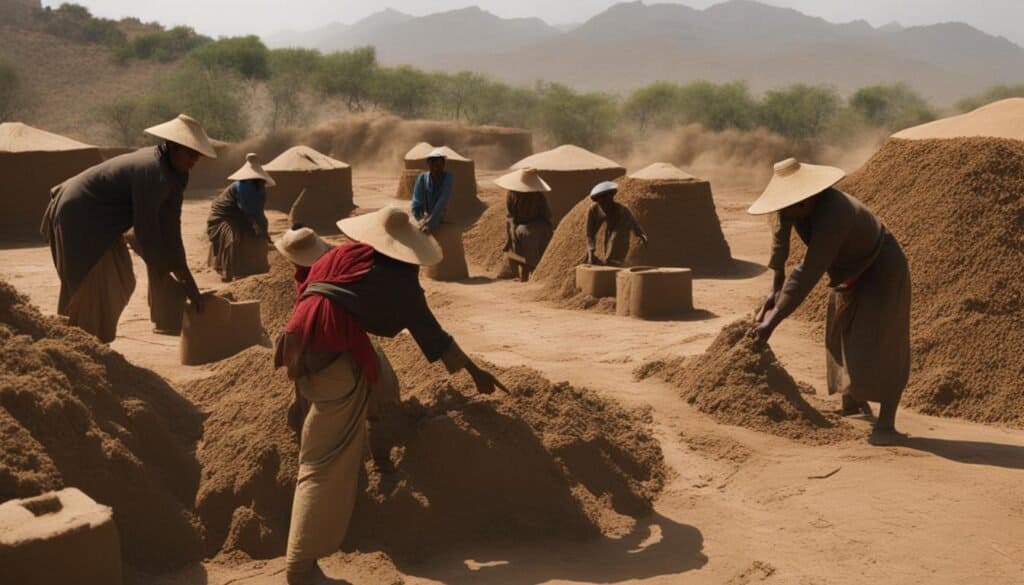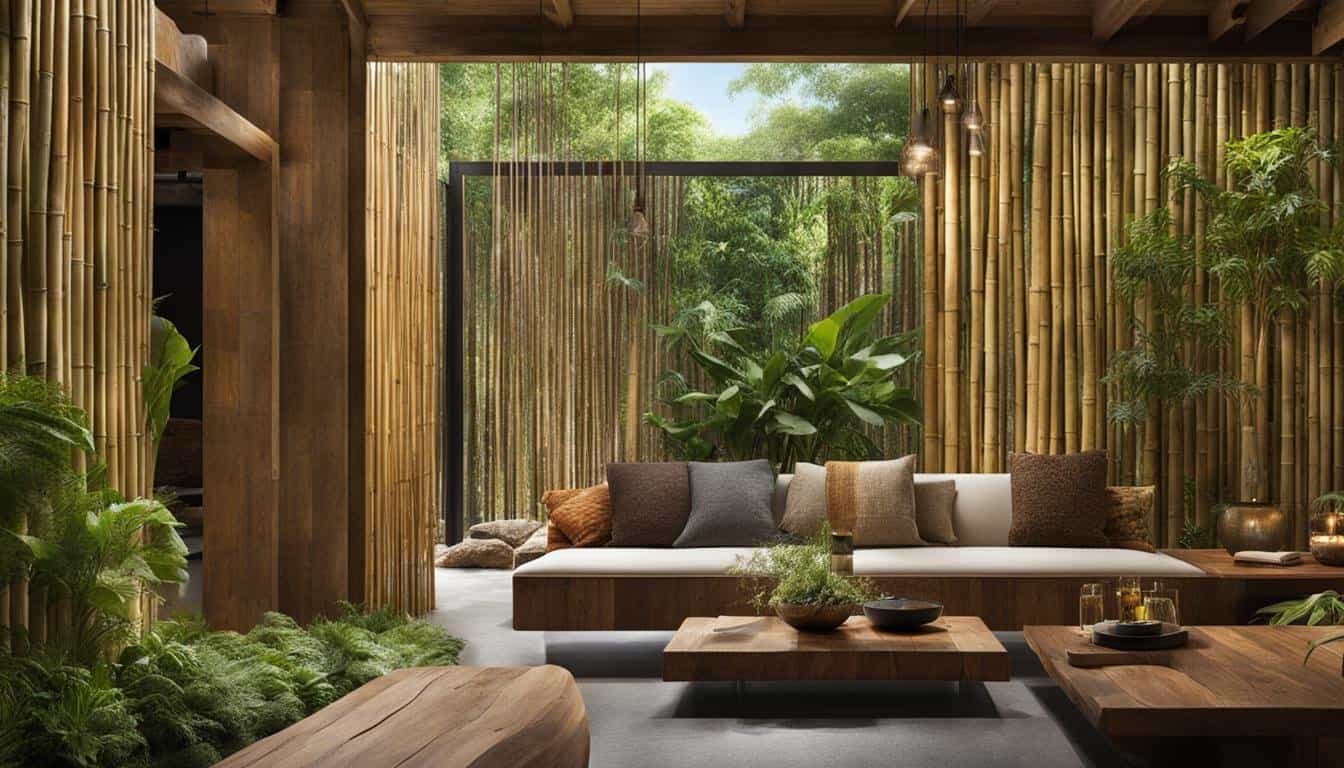Welcome to our comprehensive guide to the most sustainable materials for home construction aimed at creating eco-friendly homes with a minimal carbon footprint. We’ve researched and curated a list of materials that will help you build energy-efficient and environmentally friendly homes and reduce the overall impact of the construction process on our beautiful planet. Let’s dive in and explore the world of sustainable building together!
Key Takeaways
- Green building materials are essential for reducing carbon footprint and enhancing energy efficiency in home construction.
- Bamboo is a rapidly renewable resource that is both strong and versatile, making it an excellent eco-friendly choice.
- Recycled steel is a sustainable and durable alternative to traditional construction materials, like wood.
- Straw bale construction offers a cost-effective, energy-efficient, and environmentally friendly method for building energy-efficient homes.
- Innovations in smart glass technology significantly improve insulation and energy efficiency in buildings.
- Earthen materials, like mudbricks, provide a sustainable and visually appealing alternative to traditional bricks.
- Concrete alternatives, such as ashcrete, hempcrete, timbercrete, grasscrete, and woodcrete, offer a range of sustainable construction material options.
The Rising Tide of Sustainable Building
As green buildings take center stage in the construction industry, focusing on sustainable construction is becoming a global priority. Growing environmental concerns and the need to reduce energy costs have propelled the adoption of eco-friendly construction techniques.
Sustainable construction materials distinguish themselves by being locally sourced, recyclable, made with recycled content, durable, and produced through resource-friendly manufacturing. Traditional energy-intensive materials are now challenged by sustainable alternatives, which have less ecological impact and meet modern construction standards.
The Zebra recommends using stone for eco-friendly home construction. Stone structures are low maintenance, environmentally friendly, and any excess stone can be repurposed for home finishes like countertops or tiles.
In light of increasing energy-related CO2 emissions and environmental impact, the construction industry is actively seeking ways to minimize its carbon footprint and create energy-efficient infrastructures.
Sustainable construction is an investment not just in the environment, but also in our future.
- Locally Sourced Materials
- Recyclable and Made with Recycled Content
- Durability and Longevity
- Resource-friendly Manufacturing
These characteristics promote a greener approach to construction and contribute to reducing operational costs tied to energy consumption.
With the construction industry accounting for a significant portion of global CO2 emissions, adopting sustainable practices and materials is imperative. Moving away from traditional methods and embracing eco-friendly alternatives has the potential to mitigate environmental impact and reduce energy costs in the long run.
| Traditional Materials | Sustainable Alternatives |
|---|---|
| Concrete | Hempcrete, Ashcrete, Timbercrete |
| Bricks | Mudbricks, Woodcrete |
| Steel | Recycled Steel |
| Glass | Smart Glass |
| Wood | Bamboo, Straw Bale |
As the sector continues to evolve, the emphasis on sustainable building materials and eco-friendly construction practices will only grow, paving the way for a greener future in the industry.
Bamboo: The Strong, Fast-Growing Eco-Warrior
When it comes to sustainable building materials, bamboo stands out as a remarkable renewable resource. Offering superior strength comparable to steel and concrete, bamboo has gained recognition in the construction industry for its durability and versatility. Its rapid growth rate – up to three feet per day- sets bamboo apart from traditional timber – and its short harvest cycle of merely three years.
Bamboo thrives in various soil conditions, which allows it to grow easily in diverse environments with minimal care. From waterproof flooring to walls and roofs, bamboo’s adaptability as a building material has made it an eco-friendly choice for many construction projects. However, careful handling is necessary to preserve the bamboo’s integrity from insects and fungus without resorting to damaging pesticides.
“Bamboo’s versatility as a strong, resilient, and fast-growing renewable material has made it a popular choice for sustainable building materials.”
Below is a table outlining the advantages and considerations of using bamboo in construction projects when compared to traditional timber.
| Features | Bamboo | Traditional Timber |
|---|---|---|
| Strength | Comparable to steel and concrete | Lower than bamboo |
| Growth Rate | Up to 3 feet per day | Significantly slower |
| Harvest Cycle | 3 years | 25 years |
| Eco-Friendliness | Yes (Minimal chemical treatment required) | Varies (Depends on timber type and treatment methods) |
| Versatility | Walls, flooring, roofs, etc. | Walls, flooring, roofs, etc. |
| Pest/Fungus Resistance | Requires careful handling | Depends on timber type |
In conclusion, bamboo’s exceptional qualities as a renewable and versatile building material make it a viable option for anyone looking to build with sustainability in mind. As the demand for eco-friendly alternatives to traditional building materials continues to grow, the potential of bamboo to revolutionize the construction industry is undeniable.
Reclaimed and Recycled Steel: Building with a Conscience

Steel is an exceptionally eco-friendly material and holds the title of being the world’s most recycled material. In fact, over 60% of steel is recycled, and it is notable for being 100% recyclable. This sustainable option has significantly impacted the construction industry by offering an environmentally friendly alternative to traditional construction materials.
One of the outstanding qualities of steel is its resilience to rot, pests, fire, and warping. This resilience contributes significantly to the durability of buildings against natural disasters. Consequently, architects and builders are increasingly turning to it for structural support.
“Recycled steel has the potential to revolutionize the construction industry by reducing the need for raw materials, thereby lessening the overall impact on the environment.”
Another advantage of using recycled steel is the reduction in energy use associated with its production. When comparing the materials needed for a 2,000-square-foot wooden frame, 50 trees would be required, whereas a frame made from recycled steel would only need six scrapped cars. This is a clear indicator of the material’s environmental and energetic efficiency.
Recycling steel has numerous benefits, both economically and environmentally:
- Conserve energy by reducing the number of trees harvested.
- It lessens the demand for mining iron ore, coal, and limestone.
- Decreases greenhouse gas emissions generated during the steel production process.
- Creates new job opportunities in the recycling industry.
- Reduces landfill waste by transforming scrapped steel into valuable construction material.
With such positive attributes, it becomes increasingly apparent that utilizing recycled steel in the construction industry can lead to both ecological and financial benefits.
| Benefits | Environmental Impact | Energy Savings |
|---|---|---|
| Conservation of natural resources | Reduces deforestation and preserves natural habitats | Less energy is expended in transport and disposal of waste |
| Reduction in waste | Decrease in landfill space and waste pollution | Less energy is expended in the transport and disposal of waste |
| New job opportunities | Supports eco-friendly industry growth | Efficient use of resources helps lower operational costs |
In conclusion, the choice to incorporate reclaimed and recycled steel into modern-day construction projects is an essential step towards building with a conscience, reducing our impact on the environment, and contributing to a more sustainable future.
The Humble Straw Bale: An Ancient Answer to Modern Challenges

Straw bales offer an ancient yet innovative solution for sustainable home construction. Affordable and ecological, straw bales can replace conventional materials like concrete or gypsum to build airtight walls that naturally provide excellent insulation. Due to the density of the bales, their high flame retardancy makes them a safer alternative to wood. The environmental impact of straw is minimal as it is easily harvested and re-planted.
Not only are straw bales an effective insulator, but they also contribute to reducing energy bills and promoting a greener way of living. Let’s explore the benefits of incorporating straw bale construction into your sustainable home:
- Affordability — straw bales are made from agricultural byproducts, making them a cost-effective option for sustainable construction materials.
- Energy efficiency — straw bales provide excellent natural insulation, keeping homes warm in the winter and cool in the summer, ultimately reducing energy bills.
- Flame retardant — densely packed straw bales boast a high flame resistance due to minimal oxygen access, making them an inherently safer choice for green building projects.
- Environmentally friendly — straw is a rapidly renewable resource that can be harvested and replanted without causing ecosystem damage, contributing to a significantly lower carbon footprint.
- Aesthetic appeal — straw bale construction lends a unique and rustic look to any sustainable home, showcasing the perfect harmony between modern engineering and natural materials.
“The history of straw bale construction dates back to the late 1800s, proving that ancient methods can offer timeless solutions for sustainable living.”
Green building continues to gain prominence as the world embraces eco-friendly building materials. Straw bales remain one of the frontrunners in natural and sustainable construction materials that have stood the test of time. Their many benefits highlight the importance of re-envisioning how architects and homeowners can meet the crucial demands of both functionality and environmental consciousness in home construction.
| Characteristics | Straw Bale Construction |
|---|---|
| Affordability | Cost-effective alternative to conventional construction materials |
| Energy Efficiency | Excellent insulation helps lower energy bills |
| Flame Retardant | High flame resistance due to density |
| Environmentally Friendly | Minimal carbon footprint and renewable resource |
| Aesthetic Appeal | Rustic, earthy look that blends modern engineering with natural materials |
Smart Glass: Innovation in Energy Efficiency

Smart glass technology exemplifies innovation in energy-efficient construction. This glass can adjust its opacity in response to environmental triggers, such as sunlight, to control heat transfer and help regulate indoor temperatures, reducing reliance on heating and cooling systems. The ability of smart glass to manage heat transfer significantly enhances a building’s insulation. By selectively reducing the amount of heat that enters the interior, smart glass aids in maintaining a consistent and comfortable climate within the home, leading to lower energy consumption and reduced greenhouse gas emissions.
Regulating Temperature with Smart Tech
One of the key advantages of smart glass in sustainable building materials is its ability to save energy by regulating temperature. Through a process known as electrochromism, smart glass dynamically changes its opacity based on the amount of sunlight exposure, either absorbing or blocking light transmission. As a result, this technology keeps interiors cooler in the summer and warmer in the winter, decreasing energy bills and increasing energy efficiency.
Reducing Heat Transfer for Better Insulation
Another significant benefit of smart glass is its capacity to reduce heat transfer, thereby improving insulation. Rather than allowing excessive heat to seep into a building and strain the cooling systems, smart glass selectively blocks the heat, ensuring optimal temperature control. This translates to reduced greenhouse gas emissions and a more environmentally friendly home-building experience.
Green building materials like smart glass not only save energy but also contribute to the future of sustainable building practices.
| Advantages of Smart Glass | Impact on Home Building |
|---|---|
| Temperature Regulation | Decreased energy bills |
| Reduced Heat Transfer | Improved insulation |
| Sunlight Control | Increased comfort and less glare |
| Environmental Benefits | Lower greenhouse gas emissions |
In conclusion, smart glass is an innovative sustainable building material that provides various benefits in temperature control and energy efficiency. By incorporating this technology into new construction projects, we can make strides toward reducing the impact of home building on the environment and creating a greener, more sustainable future.
Mudbricks: Embracing Earthen Elegance

In our quest to build environmentally friendly homes, the humble mudbrick stands out from the rest. These sustainable alternatives to traditional bricks offer numerous benefits for eco-conscious builders and homeowners alike.
Mudbricks require far less energy and chemical additives to produce, with a substantially reduced carbon footprint.
Green Coast advises considering living walls or roofs in sustainable house design. These living structures, which support grasses, flowers, or shrubs, offer an innovative approach to eco-friendly construction.
Mudbricks have been used for centuries in various construction applications, primarily due to their durability and low impact on the environment. They present an aesthetically pleasing and functional option for a variety of eco-friendly construction projects.
Environmentally Friendly Production
One of the most significant advantages that mudbricks possess over traditional bricks is their environmentally friendly production process. While conventional brick-making typically requires large amounts of energy, often sourced from fossil fuels, mudbricks demand far less energy to produce. The result? A substantially reduced carbon footprint and a more sustainable building material.
Efficient Use of Natural Resources
Another point in favor of mudbricks lies in their resource efficiency. As they are composed primarily of earth, water, and straw, their production process requires minimal amounts of raw materials and can even make use of waste materials such as straw. This contrasts starkly with conventional brick production, which often entails the mining and transportation of raw materials, further straining the environment.
Reduced Time and Cost
Historically, mudbrick-making has taken significantly less time to produce than traditional bricks, resulting in lower construction costs for builders and homeowners alike. Mudbrick homes typically have lower maintenance and repair expenses due to their natural resilience against common construction issues such as dampness, pests, and decay.
| Material | Energy Input | Carbon Footprint | Production Time |
|---|---|---|---|
| Mudbrick | Low | Low | Short |
| Traditional Brick | High | High | Long |
To summarize, mudbricks offer an elegant, eco-friendly alternative to traditional bricks in various construction applications. With their reduced energy requirements, lower carbon footprint, and quicker production time, they provide a compelling choice for environmentally conscious builders and homeowners alike. So, if you’re seeking a more sustainable and attractive building material for your next construction project, consider embracing the earthen elegance of mudbricks.
Navigating the Alternatives to Traditional Concrete
In recent years, sustainable alternative construction materials such as Ashcrete, Hempcrete, Timbercrete, Grasscrete, and Woodcrete have gained popularity in the quest for environmentally friendly home remodeling solutions. These innovative materials offer similar structural integrity to traditional concrete blocks while significantly reducing CO2 emissions and energy consumption during production.
Innovations in Ashcrete and Hempcrete
Ashcrete is an eco-friendly building material that utilizes coal combustion biproducts, cement, and sand, leading to a 60% reduction in greenhouse gas emissions compared to conventional concrete. Hempcrete, on the other hand, boasts a negative carbon footprint and superior thermal properties by combining hemp fibers, lime, and water. Both materials showcase the potential to revolutionize the construction industry by prioritizing sustainability and environmental impact.
Exploring Timbercrete and Grasscrete Options
Timbercrete fuses sawdust, cement, and water to create an energy-efficient material that reuses waste products and minimizes the energy-intensive nature of traditional concrete. Grasscrete integrates grass or turf with crushed rock and water, forming a permeable and green surface alternative that merges eco-consciousness with functionality in modern construction methods.
Reaping the Benefits of Woodcrete
Woodcrete, another sustainable home construction option, consists of recycled wood chips, Portland cement, and water, offering a concrete-like material that reduces energy production by up to 85% compared to traditional concrete. With its high recycled content and innovative approach to material manufacturing, Woodcrete demonstrates the potential for a greener future in the construction industry.
FAQ on Sustainable Materials for Home Construction
Q: What building material can be used for eco-friendly construction?
A: Several materials can be used for eco-friendly construction, including cork, mass timber, mycelium, rigid foam and recycled glass. All these materials have a minimum impact on the environment and offer energy efficiency. They are one of the most sustainable and eco-friendly materials used in the building sector.
Q: How is timber used in sustainable construction?
A: Timber, and especially mass timber, is often used for construction of sustainable structures due to its carbon sequestering properties. Being a natural material, it has less carbon emissions when manufactured and shipped to the construction site compared to traditional construction materials.
Q: What’s the role of mycelium in green building?
A: Mycelium is a biodegradable material that can be used as a building material for insulation purposes. It provides a more sustainable method and is a wonderful choice for a green home.
Q: What are cork tiles and how are they used in an eco-friendly building?
A: Cork tiles, extracted from the cork oak tree, are used as a sustainable and eco-friendly building material for floor and wall coverings. They can also be used as thermal storage due to their insulating qualities. This promotes energy efficiency in the building structures of both commercial and office buildings.
Q: Can foam be eco-friendly and how is it used in green construction?
A: Yes, foam can be eco-friendly, especially when it’s a plant-based polyurethane rigid foam. This foam is used for insulation and has a significantly less environmental impact compared to conventional materials. This makes it a crucial material for any green building.
Q: What is the purpose of using recycled glass in building construction?
A: Recycled glass is used in building construction primarily as an aggregate in concrete blocks, providing texture and color to the finished product. It can also be used for insulation or as a component in green building products. The usage of recycled glass turns waste into valuable resources and decreases the materials needed to produce new glass, reducing the overall carbon footprint of the construction sector.
Q: How does using sustainable building materials profit the environment?
A: Sustainable building materials like natural lumber, mycelium, cork or recycled glass significantly reduce carbon emissions during their production. Using these materials can greatly reduce the environmental impact of the building sector. Moreover, many of these materials increase the energy efficiency of the buildings they are used in, which can result in decreased energy usage and further reduce carbon emissions.
Q: Can a house built with eco-friendly materials be as durable as one built with traditional materials?
A: Yes, a home built with eco-friendly materials can be just as durable, if not more so, than a home built with traditional materials. In many cases, materials like mass timber, stone, and cork are remarkably resilient and tend to age well, offering longevity that rivals or surpasses traditional materials. Plus, they create healthier living spaces and improve indoor air quality.
Q: Is it possible to use only eco-friendly materials in a construction?
A: While it is a goal of sustainable construction to use as many eco-friendly materials as possible, there will likely be areas of a building project that require traditional materials. However, advancements in technology and increased awareness are continuously expanding the range of eco-friendly options available, making it possible to move closer towards fully sustainable construction.
Q: Why is eco-friendly construction important for our future?
A: Eco-friendly construction is important for our future for many reasons. Not only does it conserve natural resources and reduce waste, but it also creates healthier living environments, and is integral to combating climate change. With buildings accounting for a significant portion of global carbon emissions, the choice of materials can substantially reduce this impact, contributing to a more sustainable future.





Leave a Reply